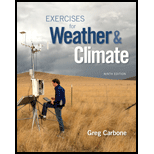
The Earth–Sun orientation will change throughout the year as Earth revolves around the Sun. Using Figures 2-3 and 2-4 as models, sketch two similar diagrams for each date given to the right and below. First draw Earth’s axis and equator on the globe. Then, on the “sunny side” of the globe, draw a short line representing a flat surface at 66.5° N, 30° N, 0°, and 23.5° S, a stick figure at each site with the Sun’s rays striking the flat surface at the feet of the stick figure. On the profile view, draw the Sun’s rays striking the flat surface transcribing the angles that you drew on the globe.
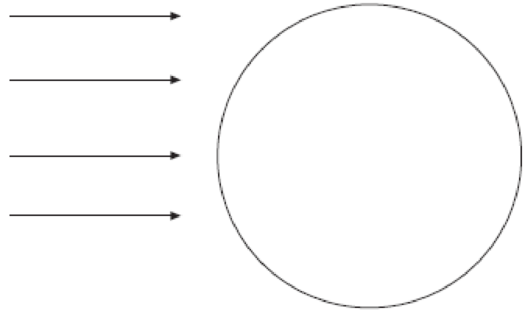
Sun’s rays striking Earth on March 21.

Profile view at Earth’s surface: solar noon on March 21.
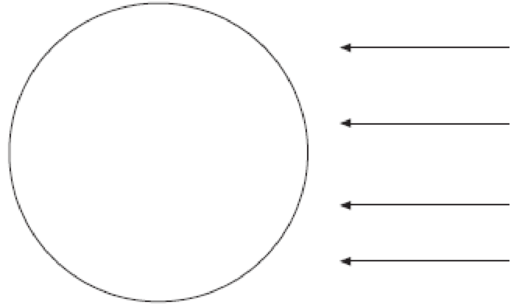
Sun’s rays striking Earth on June 21.

Profile view at Earth’s surface: solar noon on June 21.
Sketch representation of the incidence of the Sun’s rays on the images given in the question, on March 21 and June 21.
Answer to Problem 1E
On March 21, which is the time of vernal equinox on the Northern Hemisphere and autumn equinox in the Southern Hemisphere, there will be direct incidence of sunlight on the equator as well as on the other latitudes north and south of the equator. The figures given below represent the angle of incidence of insolation on various latitudes.
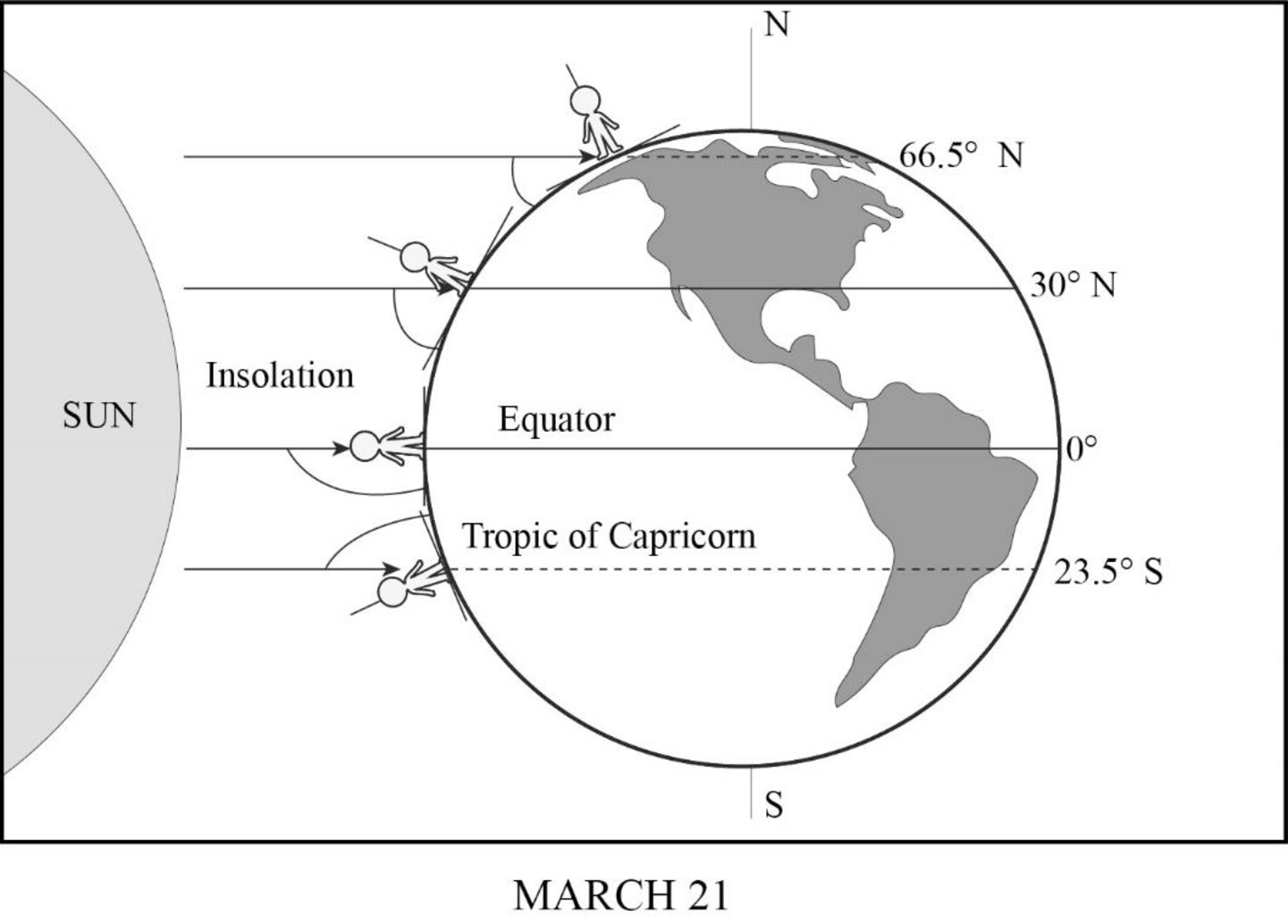

On June 21, which is the time of Summer Solstice in the Northern Hemisphere, the Sun will be more direct over the Northern Hemisphere, indicating the beginning of Summer season. The North Pole will be inclined at an angle of
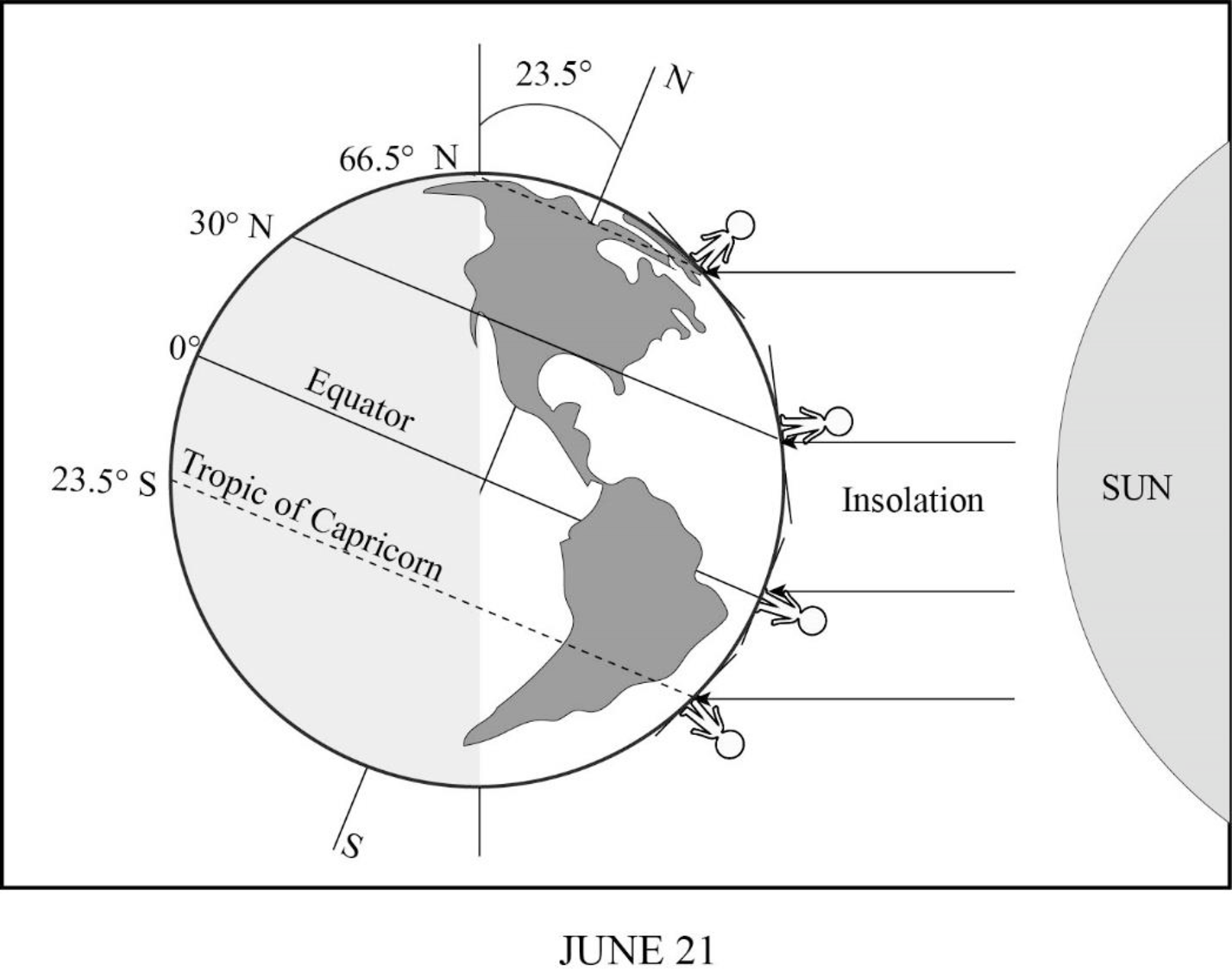

Explanation of Solution
On March 21, the Earth exhibits an equinox time. It is generally known as vernal equinox in the Northern hemisphere, while in the Southern Hemisphere, it is known as autumn equinox. During equinox, neither of the poles would be specifically inclined toward the Sun nor would any of the poles be receiving more insolation. Instead, both the hemispheres will experience equal duration of day and night. The insolation might fall on the Earth vertically, which means the equator along with latitudes above and below it receives vertical rays of the Sun.
June 21 is referred to as the June Solstice or Summer Solstice in the Northern Hemisphere. Solstice is the time during which one of the hemispheres will be facing the Sun more directly. During June Solstice, the Earth’s rotation axis over the North Pole is most directed or inclined (by nearly
Want to see more full solutions like this?
Chapter 2 Solutions
Exercises for Weather & Climate (9th Edition)
Additional Science Textbook Solutions
Campbell Essential Biology (7th Edition)
Microbiology with Diseases by Body System (5th Edition)
Human Physiology: An Integrated Approach (8th Edition)
Introductory Chemistry (6th Edition)
Chemistry: An Introduction to General, Organic, and Biological Chemistry (13th Edition)
Campbell Biology (11th Edition)
- At the large scale of the major ocean basins, do ocean currents tend to flow in a cyclonic or anti-cyclonic direction? How is this evidenced in the map of average sea-surface temperatures belowarrow_forwardThe map below shows sea-surface temperature (SST) anomalies during El Niño years. Please explain what is meant by “anomaly”. In El Niño years, which side (east or west) of the tropical Pacific Ocean experiences anomalously high precipitation totals and which side experiences anomalously low precipitation totals? Why?arrow_forwardWhen a body of cold air near earth’s surface moves into a region occupied by warmer air, the point of intersection is known as a cold front. What does this do to the vertical motion of the warm air and why? What does this do to surface pressure ahead of the cold front and why ?Does this tend to instigate cyclonic or anti-cyclonic atmospheric rotation ? Does this rotation tend to bring relatively warm air toward the poles or toward the lower latitudesarrow_forward
- As the atmosphere and ocean move, they are deflected due to the spin of the earth. Is the deflection to the right or to the left in the Northern Hemisphere? Is this the same in the Southern Hemisphere ? In both hemispheres, a low pressure will instigate cyclonic flow. In the Northern Hemisphere, does cyclonic flow circulate in a clockwise or counter-clockwise direction and whyarrow_forwardIs the seasonal cycle in temperature (temperature difference between warmest and coolest season) stronger in the tropics or high latitudes, and why ?How about in “maritime” areas that are regularly exposed to air that was recently over the ocean versus more continental areas, and why?arrow_forwardThe image shows the two different crusts on earth. Fill in the blanks with short answers (numbered as 1,2,3, and 4) for the rock types and the name of the crust. Question 3 options: Blank # 1 Blank # 2 Blank # 3 Blank # 4arrow_forward
- you are working on a crew and you overhear one of the people on the crew tell a member of the general public something that is not true. what do you do?arrow_forwardResearch question ideas for Benthic invertebrates as an indicator species for climate change, mapping changes in ecosystems (Historical Analysis & GIS) use where questionsarrow_forwardResearch question ideas for Benthic invertebrates as an indicator species for climate change, mapping changes in ecosystems (Historical Analysis & GIS) use where questionsarrow_forward
- Brief background for supporting of efforts should be made to create distance and separate crops that produce pollutants such as ecoli (i.e. animal farming) from crops that don’t (i.e. lettuce) to protect these latter crops despite the extra costs and logistical challenges.arrow_forwardOpening statement for supporting of efforts should be made to create distance and separate crops that produce pollutants such as ecoli (i.e. animal farming) from crops that don’t (i.e. lettuce) to protect these lattercrops despite the extra costs and logistical challenges.arrow_forwardInstructions Chapter 1. Philosophy and Fundamental concepts In this chapter, we discussed the five fundamental concepts of environmental geology: human population growth, sustainability, systems and change, hazardous Earth processes, and scientific knowledge and values. One interesting analogy for Earth is the Gaia hypothesis, which proposes that living organisms interact with their inorganic surroundings to form a synergistic, self-regulating system that helps maintain and sustain conditions for life on the planet. Now my question is Do you think the Earth is a living organism? Why or why not? I understand that many students use generative AI to assist with homework. While AI is undoubtedly a valuable tool for providing information, I believe that human judgment and analytical skills surpass what AI can achieve. My hope is that these assignments will help develop and strengthen your critical thinking skills. Here are answers from Chatgpt: "Do you think the Earth is a…arrow_forward
 Applications and Investigations in Earth Science ...Earth ScienceISBN:9780134746241Author:Edward J. Tarbuck, Frederick K. Lutgens, Dennis G. TasaPublisher:PEARSON
Applications and Investigations in Earth Science ...Earth ScienceISBN:9780134746241Author:Edward J. Tarbuck, Frederick K. Lutgens, Dennis G. TasaPublisher:PEARSON Exercises for Weather & Climate (9th Edition)Earth ScienceISBN:9780134041360Author:Greg CarbonePublisher:PEARSON
Exercises for Weather & Climate (9th Edition)Earth ScienceISBN:9780134041360Author:Greg CarbonePublisher:PEARSON Environmental ScienceEarth ScienceISBN:9781260153125Author:William P Cunningham Prof., Mary Ann Cunningham ProfessorPublisher:McGraw-Hill Education
Environmental ScienceEarth ScienceISBN:9781260153125Author:William P Cunningham Prof., Mary Ann Cunningham ProfessorPublisher:McGraw-Hill Education Earth Science (15th Edition)Earth ScienceISBN:9780134543536Author:Edward J. Tarbuck, Frederick K. Lutgens, Dennis G. TasaPublisher:PEARSON
Earth Science (15th Edition)Earth ScienceISBN:9780134543536Author:Edward J. Tarbuck, Frederick K. Lutgens, Dennis G. TasaPublisher:PEARSON Environmental Science (MindTap Course List)Earth ScienceISBN:9781337569613Author:G. Tyler Miller, Scott SpoolmanPublisher:Cengage Learning
Environmental Science (MindTap Course List)Earth ScienceISBN:9781337569613Author:G. Tyler Miller, Scott SpoolmanPublisher:Cengage Learning Physical GeologyEarth ScienceISBN:9781259916823Author:Plummer, Charles C., CARLSON, Diane H., Hammersley, LisaPublisher:Mcgraw-hill Education,
Physical GeologyEarth ScienceISBN:9781259916823Author:Plummer, Charles C., CARLSON, Diane H., Hammersley, LisaPublisher:Mcgraw-hill Education,





